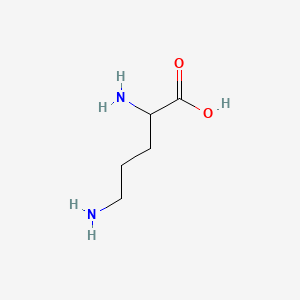| MeSH term | MeSH ID | Detail |
|---|---|---|
| Pancreatic Neoplasms | D010190 | 77 associated lipids |
| Inflammation | D007249 | 119 associated lipids |
| Reperfusion Injury | D015427 | 65 associated lipids |
| Colitis | D003092 | 69 associated lipids |
| Colonic Neoplasms | D003110 | 161 associated lipids |
| Diabetes Mellitus, Type 2 | D003924 | 87 associated lipids |
| Diabetic Nephropathies | D003928 | 39 associated lipids |
| Fatty Liver | D005234 | 48 associated lipids |
| Cataract | D002386 | 34 associated lipids |
| Diabetes Mellitus, Experimental | D003921 | 85 associated lipids |
2,5-diaminopentanoic acid
2,5-diaminopentanoic acid is a lipid of Fatty Acyls (FA) class. The involved functions are known as Vasodilation, Intestinal Absorption and Pinocytosis. 2,5-diaminopentanoic acid often locates in Mitochondria, Microfilaments, NADH dehydrogenase complex and respiratory chain complex III location sensu Eukarya. The associated genes with 2,5-diaminopentanoic acid are GAPDH gene and iberiotoxin.
Cross Reference
Introduction
To understand associated biological information of 2,5-diaminopentanoic acid, we collected biological information of abnormalities, associated pathways, cellular/molecular locations, biological functions, related genes/proteins, lipids and common seen animal/experimental models with organized paragraphs from literatures.
What diseases are associated with 2,5-diaminopentanoic acid?
There are no associated biomedical information in the current reference collection.
Possible diseases from mapped MeSH terms on references
We collected disease MeSH terms mapped to the references associated with 2,5-diaminopentanoic acid
PubChem Associated disorders and diseases
What pathways are associated with 2,5-diaminopentanoic acid
There are no associated biomedical information in the current reference collection.
PubChem Biomolecular Interactions and Pathways
Link to PubChem Biomolecular Interactions and PathwaysWhat cellular locations are associated with 2,5-diaminopentanoic acid?
Visualization in cellular structure
Associated locations are in red color. Not associated locations are in black.
Related references are published most in these journals:
| Location | Cross reference | Weighted score | Related literatures |
|---|
What functions are associated with 2,5-diaminopentanoic acid?
Related references are published most in these journals:
| Function | Cross reference | Weighted score | Related literatures |
|---|
What lipids are associated with 2,5-diaminopentanoic acid?
There are no associated biomedical information in the current reference collection.
What genes are associated with 2,5-diaminopentanoic acid?
Related references are published most in these journals:
| Gene | Cross reference | Weighted score | Related literatures |
|---|
What common seen animal models are associated with 2,5-diaminopentanoic acid?
There are no associated biomedical information in the current reference collection.
NCBI Entrez Crosslinks
All references with 2,5-diaminopentanoic acid
Download all related citations| Authors | Title | Published | Journal | PubMed Link |
|---|---|---|---|---|
| Sakanaka A et al. | Arginine-Ornithine Antiporter ArcD Controls Arginine Metabolism and Interspecies Biofilm Development of Streptococcus gordonii. | 2015 | J. Biol. Chem. | pmid:26085091 |
| Horibata S et al. | Utilization of the Soft Agar Colony Formation Assay to Identify Inhibitors of Tumorigenicity in Breast Cancer Cells. | 2015 | J Vis Exp | pmid:26067809 |
| AbdElgawad H et al. | Grassland species differentially regulate proline concentrations under future climate conditions: an integrated biochemical and modelling approach. | 2015 | New Phytol. | pmid:26037253 |
| Coutelier M et al. | Alteration of ornithine metabolism leads to dominant and recessive hereditary spastic paraplegia. | 2015 | Brain | pmid:26026163 |
| Costa IA et al. | Recombinant interleukin-1β dilates steelhead trout coronary microvessels: effect of temperature and role of the endothelium, nitric oxide and prostaglandins. | 2015 | J. Exp. Biol. | pmid:26026045 |
| Scott JA et al. | Plasma arginine metabolites reflect airway dysfunction in a murine model of allergic airway inflammation. | 2015 | J. Appl. Physiol. | pmid:25979935 |
| Ballantyne LL et al. | Strategies to rescue the consequences of inducible arginase-1 deficiency in mice. | 2015 | PLoS ONE | pmid:25938595 |
| Zou XY et al. | Glyoxalase I is differentially expressed in cutaneous neoplasms and contributes to the progression of squamous cell carcinoma. | 2015 | J. Invest. Dermatol. | pmid:25184957 |
| Jourdan M et al. | Citrulline stimulates muscle protein synthesis in the post-absorptive state in healthy people fed a low-protein diet - A pilot study. | 2015 | Clin Nutr | pmid:24972455 |
| Šišková P et al. | Phenotypes of Escherichia coli isolated from urine: Differences between extended-spectrum β-lactamase producers and sensitive strains. | 2015 | J Microbiol Immunol Infect | pmid:24865414 |
